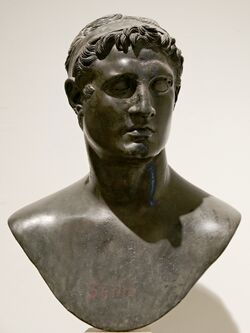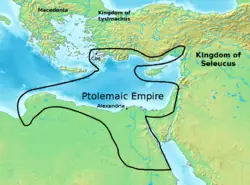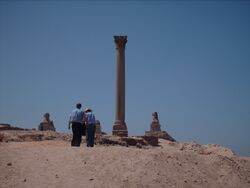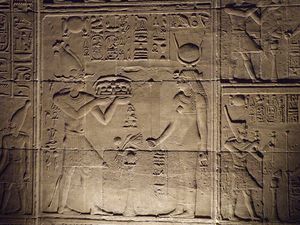How Did Ptolemy II Revitalize Ancient Egypt
By the time Ptolemy II Philadelphus (ruled 284-246 BC) came to the throne of Egypt, Egypt had long ceased being an important power in the Mediterranean Basin or the Near East. The last great Egyptian dynasty was the Twenty-Sixth (664-525 BC), after which a series of weak native dynasties came to the throne interspersed with two periods of Achaemenid Persian rule. So when Alexander the Great conquered Egypt in 332 BC, it may have seemed like just another group of foreigners was going to rule Egypt from afar, making sure to deplete as many of her resources in the process.
But the reality is that early Ptolemaic rulers – who were Macedonian Greek rulers named for the first king of their dynasty, Ptolemy I (reigned 305-282 BC) – especially Ptolemy II, helped revitalize Egypt culturally and made it essential militarily and economically once more in the region. Ptolemy II accomplished this feat by completing some ambitious building projects initiated by his father, introducing elements of Greek culture to Egypt while respecting native Egyptian traditions, and by revitalizing Egypt’s military.
The Greeks and Egypt
Long before the Macedonian Greeks ruled Egypt, other Greeks had long histories of interactions with Egypt and the Egyptians going back to the Middle Bronze Age. The earliest recorded interactions between the Egyptians and people from Greece and the Greek Isles are found in tombs and texts from Egypt’s Middle Kingdom (1974-1640 BC). The contact was probably limited for the most and primarily traded with the Minoans of Crete and then later in the New Kingdom (1550-1075 BC) with the Myceneans of the Cyclades Islands and mainland Greece. By the seventh century BC, the Greeks had begun expanding their influence in the Mediterranean Basin by colonizing coastal areas outside of Greece and by offering their services as mercenaries to non-Greeks, which is how they established a permanent foothold in Egypt.
The first king of Egypt’s Twenty-Sixth Dynasty, Psamtek I (ruled 664-610 BC), invited Greek mercenaries and merchants to Egypt and allowed them to establish the colony of Naukratis and a Greek section of Memphis. Later Greeks, especially from Athens, became involved with Egyptian efforts to revolt against Achaemenid Persian rule. [1] So by the time Alexander and his army of Macedonians entered Egypt, the Egyptians were familiar with Greeks, and the Greeks were familiar with Egyptians.
When Alexander and his army drove the Persians from Egypt, they were welcomed as liberators for the most part. He visited the oracle of Amun in the Siwa Oasis, was proclaimed the legitimate pharaoh, and was coronated in Memphis, the traditional political capital of ancient Egypt. [2] Although Alexander left Egypt and never returned, he mainly laid the foundations for a new Macedonian Greek dynasty to rule the Nile Valley.
After Alexander the Great died, his top generals divided his kingdom up among themselves. Ptolemy Lagos, later known as Ptolemy I Soter of Egypt, received the prize of Egypt, although he had to defeat general Perdiccas for that reward. [3] Ptolemy I wasted little time rebuilding Egypt in his image. Some of the more impressive aspects of Ptolemy I’s reign are detailed in the Egyptian language Satrap Stela, foremost of which was his construction of the new capital, Alexandria.[4] Alexandria may have been Ptolemy I’s vision, but it was the responsibility of his son and successor, Ptolemy II, to make that vision a reality.
Ptolemy II’s Building Projects
The creation of Alexandria was an ambitious project in itself since there was only a small settlement in the vicinity when Ptolemy took the throne, but it was the major monuments and institutions he began construction of that made the city truly famous. The most famous of all the buildings Ptolemy began construction of that was completed during Ptolemy II’s reign was the Lighthouse of Alexandria, which was one of the Seven Wonders of the Ancient World. Also known as the Pharos Lighthouse for the island in the Alexandria harbor where it was located, construction of the landmark probably began in the 290s and continued until the 270s BC. [5]
Almost as magnificent as the Lighthouse and arguably more important culturally speaking was the Library of Alexandria, which again is believed to have been the idea of Ptolemy I but finally completed by Ptolemy II. [6] Ancient sources also credit Ptolemy II with building projects that were not as glamorous or well-known, but just as important to ancient Egypt’s prosperity.
The first century BC Greek geographer, Strabo, and the first century BC Greek historian, Diodorus, both mention that an ancient canal was completed during the Ptolemaic Dynasty that connected the Red Sea to a branch of the Nile River. Strabo wrote that it was completed by “Ptolemaic Kings,” [7] while Diodorus specifically stated that it was completed by the “second Ptolemy.” [8] Connecting the Red Sea region to the Nile Valley appeared to have been one of Ptolemy II’s major initiatives. Besides completing the Red Sea Canal, he also built a road from the Red Sea port of Berenice to the city of Coptos on the Nile River. Strabo wrote:
“Thence one crosses an isthmus, which extends to the Red Sea, near a city Berenice. The city has no harbor, but on account of the favorable lay of the isthmus has convenient landing-places. It is said that Philadelphus was the first person, by means of an army, to cut this road, which is without water, and to build stations, as though for the travels of merchants on camels, and that he did this because the Red Sea was hard to navigate, particularly for those who set sail from its innermost recess. So the utility of his plan was shown by experience to be great, and now all the Indian merchandise, as well as the Arabian and such of the Aethiopian as is brought down by the Arabian Gulf, is carried to Coptos, which is the emporium for such cargoes.” [9]
Ptolemy II and the Economy
The primary reason why Ptolemy II completed the Red Sea Canal and built the road from Berenice to Coptos was to facilitate trade and economic activity in Egypt. For centuries the Egyptian economy had stagnated, but new economic ideas introduced by Ptolemy I and further pursued by Ptolemy II helped make Egypt an important trading partner in the region once more. Coinage was introduced on a wide scale, and royal banks were franchised and given tax-collecting powers, which helped to make the economy grow and be more efficient [10] The Ptolemies continued to export grain as the Egyptians had done before them, but they also diversified their exports by taking advantage of the papyrus and rare oils that Egypt had to offer. [11]
Ptolemy II the Conquering Pharaoh
The later Ptolemaic kings became embroiled in a series of never-ending wars with their cousins of the Seleucid Empire in the east, but Ptolemy II instead turned his eyes to the south just as many Egyptian kings had done before him. According to Diodorus, Ptolemy II led a major campaign south into Nubia, which the Greeks knew as “Ethiopia,” becoming the first Greek to go that far south.
“For from earliest times until Ptolemy who was called Philadelphius, not only did no Greeks ever cross over into Ethiopia, but none ascended even as far as the boundaries of Egypt – to such an extent were all these regions inhospitable to foreigners and altogether dangerous; but after this king had made an expedition into Ethiopia with an army of Greeks, being the first to do so, the facts about that country from that time forth have been more accurately learned."[12]
Whether or not Ptolemy II was consciously channeling the earlier pharaohs when he invaded Nubia is unknown, but he did make conscious efforts to recognize ancient Egyptian culture while he added elements of Greek/Hellenistic culture to Egypt.
Ptolemy II’s Cultural Program
Ptolemy II allowed the native Egyptian cults to continue and even promoted them to some extent, at least as far as it benefited him and his family. Ptolemy II and his successor did, though, curtail the power of the native priesthood by taking control of the temple revenues. [13] When it came to the sometimes contentious coexistence of ancient Egyptian and Hellenistic culture, Ptolemy attempted to walk a middle ground. Besides promoting some of the native cults, Ptolemy II also patronized native Egyptian scholars who were well-versed in the backgrounds of both cultures.
Ptolemy II was also the major patron of Manetho, a high-priest of Re from the Delta city of Sebennytos, who lived during the reigns of the first three Ptolemies. Manetho is best known for his Greek language chronological history of the kings of Egypt, Aegyptiaca, which only survives today in fragments recorded by historians in late antiquity. Manetho is believed to have been one of the original priests of the Serapis cult, which was a Greek version of the Egyptian Apis cult. Ptolemy II envisioned that that cult would bring together the elite of Egyptian society with the Greeks of Alexandria in what can only be described as a truly Hellenistic venture. [14] Ptolemy II also brought other Hellenistic ideas to Egypt during his rule.
One of the more interesting Hellenistic concepts Ptolemy II introduced to Egypt was known as the “Ptolemaieia,” which was a festival Ptolemy II held in Alexandria in honor of his father. Like the better known Olympics, the Ptolemaieia was held every four years, featuring sporting events by participants from around the Greek-speaking world and several parades with mechanical floats. [15]
One final thing that Ptolemy II introduced to Egypt, at least the royal family ruling it, was something that he wrongly believed was a long royal tradition: consanguineous/incestuous marriage. Ptolemy II married his full-sister, Arsinoe II, presumably to appear more Egyptian in the eyes of the native Egyptian priests and other native elites. [16] The reality is, though, that the Egyptians were never known to practice such marriages among their royalty, not with any frequency anyway, so the idea probably resulted from a Greek misunderstanding of the Egyptian use of the words “brother” and “sister.” With that said, the precedent was established and most of the later Ptolemies practiced consanguineous marriage. [17]
Conclusion
Ancient Egypt was a civilization that had many cultural peaks and valleys. When Alexander the Great conquered Egypt in 332 BC the land of the pharaohs was in one of its deepest valleys since the formation of the Egyptian state around 3100 BC. After the Macedonian Greek Ptolemy Dynasty was established, Ptolemy II revitalized Egypt by completing his father’s ambitious building program, embarking on foreign conquest, introducing new economic ideas, and pursuing a cultural program that respected the native Egyptian traditions while introducing aspects of Hellenism. Because of Ptolemy II’s efforts, Egypt once more became one of the most important kings in the region and would be so for another 200 years.
References
- Jump up ↑ Shaw, Ian, and Paul Nicholson. The Dictionary of Ancient Egypt. (New York: Harry N. Abrams, 1995), p. 116
- Jump up ↑ Chauveau, Michael. Egypt in the Age of Cleopatra: History and Society under the Ptolemies. Translated by David Lorton. (Ithaca, New York: Cornell University Press, 2000), p. 121
- Jump up ↑ Bowman, Alan K. Egypt after the Pharaohs: 332 BC-AD 642 from Alexander to the Arab Conquest. (Los Angeles: University of California Press, 1996), p. 22
- Jump up ↑ Chauveau, p. 38
- Jump up ↑ Scheidel, Walter. “Creating a Metropolis: A Comparative Demographic Perspective.” In Ancient Alexandria between Egypt and Greece. Edited by W.V. Harris and Giovanni Ruffini. (Leiden: Brill, 2004), p. 318
- Jump up ↑ Casson, Lionel. Libraries in the Ancient World. (New Haven, Connecticut: Yale University Press, 2001), p. 22
- Jump up ↑ Strabo. Geography. Translated by Horace Leonard Jones. (Cambridge, Massachusetts: Harvard University Press, 2001), XVII, 1, 25
- Jump up ↑ Diodorus Siculus. The Library of History. Translated by C.H. Oldfather. (Cambridge, Massachusetts: Harvard University Press, 2004), II, 13
- Jump up ↑ Strabo, XVII, I, 45
- Jump up ↑ Chauveau, pgs. 82-82
- Jump up ↑ Chauveau, p. 93
- Jump up ↑ Diodorus, I, 37
- Jump up ↑ Chauveau, p. 116
- Jump up ↑ Verbrugghe, Gerald P. and John M. Wickersham. Berossos and Manetho, Introduced and Translated: Native Traditions in Ancient Mesopotamia and Egypt. (Ann Arbor: University of Michigan Press, 2001), p. 96
- Jump up ↑ Bowman, pgs. 24-25
- Jump up ↑ Chauveau, p. 10
- Jump up ↑ Bowman, p. 24



